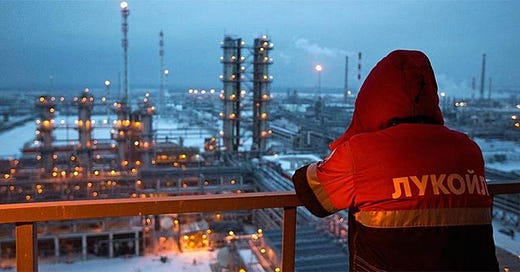Weekly Economic Update on Russia
By Madi Kapparov, 16 June 2025
This is a new newsletter by Eurofile. Every Monday evening, we publish a weekly review of major economic news from Russia with a brief analysis. As most data on Russia’s economy is provided by the Russian state, many of the sources referenced will be either Russian state-controlled media or Kremlin-connected state and non-state organizations. Exercise caution using these sources.
Flare up in the Middle East driving up oil prices, a boon for Russia?
Israel’s operation against Iran’s nuclear program and the subsequent exchange in missile and drone strikes drove up the global oil price. At the time of writing, both WTI and Brent cooled off to about $71-72 per barrel after rising above $75 per barrel late last week. As the price of Urals, Russia’s oil brand, strongly correlated with the global oil price, some in the Kremlin might rejoice at the much-needed reprieve. And it could not have come at a better time – just two weeks ago Russia reported a dismal federal deficit forecast partly driven by the falling oil and gas revenues. Russia's oil and gas revenue fell by 35% year-on-year in May to 512.7 billion rubles ($6.55 billion).
However, the reprieve might be short-lived. Last week, ahead of the Israeli strikes, the US Energy Information Administration lowered its forecast for global oil prices to an average of $61 per barrel of Brent for 2025, down from May’s forecast of $62, and maintained the 2026 expected price at $59. The oil market is experiencing oversupply with OPEC+ steadily expanding production along with US producers hitting all-time high daily extraction volumes. This oversupply is accompanied by global macroeconomic concerns of a potential recession in the US and most parts of the world in the second half of 2025, especially against the backdrop of tariff uncertainty introduced by the Trump administration.
Though it is too early to tell how long the current hot phase of the Iran-Israel conflict will last, it is worth noting that markets tend to overreact to negative news. While there are reasons to remain optimistic about the oil price returning to the downward trend, there are some concerns. Israel and Iran are striking each other’s energy infrastructure, e.g. Israel struck the Shahran fuel depot in northern Tehran, a major logistical hub supplying 8 million liters of gasoline daily. Iran also has the option of extending the conflict into the Strait of Hormuz, where 21% of global petroleum liquids transit. However, Iranian leadership might strive to maintain the initial *public* sympathies expressed by Arab states in the game of propaganda and diplomacy. Thus, threatening steady revenue streams of Arab nations in the Persian Gulf might not be in Iran’s interests.
In my subjective opinion, the current phase of the conflict is unlikely to last for more than a few weeks as Iran is not capable of maintaining sufficient munitions production volumes, especially with Israel systematically targeting their facilities. Moreover, the two countries do not share borders. But take these statements with a grain of salt, as my knowledge of the Middle East is limited and I am not a military analyst.
Finally, Russia still has another major concern just over the horizon – in a future round of sanctions, the EU might implement a $45 per barrel price cap vs. the current $60. However, the US opposes the proposed reduction. Russia is estimated to breakeven at around $40 per barrel.
Reactions in Russia to the Central Bank rate cut
Though it is too early to observe any meaningful impact on Russia’s economy from the reduction of the Central Bank rate, that we discussed in last week’s newsletter, many experts in Russia expect further cuts in the rate. Dmitry Donetsky, head of Solid, a Russian brokerage, expects another 1% cut at the next Central Bank meeting on July 25. High inflationary pressures and “external” factors are cited as the main reasons to Russia’s Central Bank taking a cautious and gradual approach to rate cuts.
RIA Novosti reports that most banks in Russia plan to reduce mortgage and consumer loan rates following the Central Bank rate cut. So far three banks, Sberbank, VTB, and Dom.RF, announced planned cuts ranging from 1.5% to 3.5%. However, loan rate cuts are mirrored by deposit rate cuts. All banks reviewed by RBC have already implemented 0.5% to 2.0% deposit rate cuts with an average reduction of 0.67% for a one-year deposit.
Inflationary pressures remain
Last week, Monique and I discussed live “The Great Potato Crisis” where we talked about the possible causes of the double digit inflation for foodstuffs in Russia, especially potatoes. Inflation in general is an ongoing story and will likely be featured every week.
Fontanka, a St. Petersburg-focused outlet closely connected to the local FSB office, republished last week ROMIR’s report on consumer spending in April. ROMIR found that an average Russian spent 34.6% of their income on food in April 2025, up 6% year-on-year. “[These trends] indicate relatively low wealth of our population,” stated an expert cited by Fontanka. “This tells us that most citizens have unhealthy incomes. And the main culprit is inflation,” he added. The story was reported in mid-May by liberal media, such as Moscow Times and Holod.
Moskovsky Komsomolets (MK), another Russian outlet with ties to the FSB, yesterday reported on “Record indexation in a decade.” While Russia loves setting records, this record is unlikely to make many Russians happy – indexation is applied to “housing and communal services tariffs” (maintenance and utility bills) starting from July 1. On average, every family in Russia is to pay 11.9% more in utility and maintenance bills, and as high as 21% more in some parts of the country. This increase is more than the official annual inflation rate of 9.88% for May 2025.
Foodstuffs increased in price by 0.26% in May (or 12.49% on an annualized basis). Services became more expensive by an average of 1.34% (in annual terms - by 12.55%). Among non-food products, prices for cameras fell significantly - by 3.2%, and televisions - by 2.7%. Prices for medicines increased significantly in May – by 0.74%.
Gasoline prices in Russia are setting new records as well. At the St. Petersburg exchange (SPIMEX) at June 16 close 92 RON and 95 RON were 5% and 10% higher vs. last year. While previously, gasoline prices in Russia rose sharply after Ukrainian strikes against their refineries, the most recent rise is driven by the expanding domestic consumption. Moreover, gasoline exports in May were 47% lower year-on-year.
Rostselmash might shut down, mass layoffs will follow
Rostselmash, Russia’s largest agricultural machinery maker, stated that if in the coming months the company does not sell at least 2500 tractors and harvesters the company will shut down and mass layoffs will follow. Earlier in April, the company laid off 2000 employees. Then in May 15000 employees were furloughed. Vice-speaker of the Russian Duma, Vikoria Abramchenko, representing Rostov Oblast, where Rostselmash is based, stated that all “anti-crisis” measures were already implemented.
No more subsidized loans for electronics manufacturing
Financing of preferential loans for Russian domestic manufacturers of electronics and telecom equipment under Government Resolution No. 407 of 2022 has been suspended, two top managers of equipment manufacturing companies told Kommersant. Loan subsidies were launched in 2022 to purchase electronic components restricted by sanctions. This sector virtually entirely exists to support Russia’s war against Ukraine. The cut in subsidies might be an indication that the Kremlin is reshuffling the funds to more urgent war needs.
This is it for today. Until next week.








I just noticed that one of the links has been removed, namely by RIA Novosti. Hence, the awkward sentence is missing a verb that was hyperlinked. I was not aware of the Substack policy.